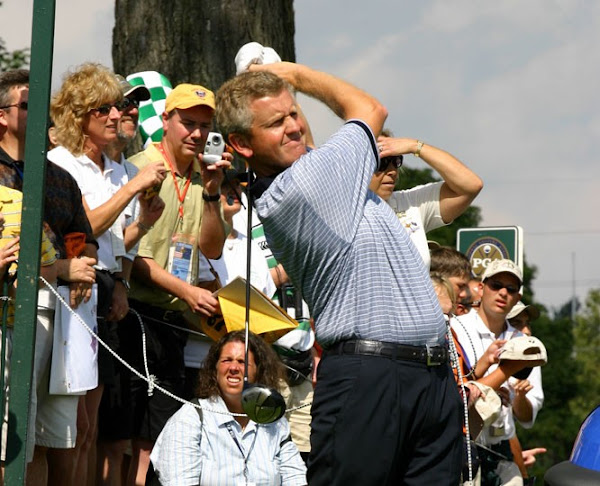Golfers Who Finished 2nd in Majors Most Often Without Winning
Finishing second-place in multiple major championships is a pretty good indication of a very good golfer — even if the golfer never wins a major. That becomes obvious when you see the names of the golfers on the list of those with the most runner-up finishes in majors without winning one.
There are four golfers on the following list, golfers who never won one of the men's majors, but but who finished in second place multiple times. Two of the golfers are members of the World Golf Hall of Fame. And cases can be made for the induction of the other two.
The List: Most Runner-Up Finishes in Majors But No Wins
Colin Montgomerie, 5 Second-Place Finishes
Monty is the record-holder for most major runners-up without any major championship victories. Two of his second-place finishes were the results of playoffs.- 1994 U.S. Open: Montgomerie lost in a 3-way playoff against Ernie Els and Loren Roberts. Els won the title by shooting 74, then beating Roberts in sudden death. Montgomerie was out of it with a 78 in the 18-hole playoff.
- 1995 PGA Championship: Birdies on the final three holes of regulation put Montgomerie in a tie with Steve Elkington at 17-under, which, at that time, was a record-low score in relation to par in a men's major. But Elkington made a 35-foot birdie putt on the first sudden-death hole to win.
- 1997 U.S. Open: Monty finished second to Els in a U.S. Open for the second time. They were tied until Montgomerie bogeyed the second-to-last hole; Els won by that single stroke.
- 2005 British Open: This was his best finish in the Open Championship, but his second-place here wasn't close: Tiger Woods beat him by five strokes.
- 2006 U.S. Open: Montgomerie made a 50-foot birdie putt on the 71st hole to tie for the lead. But a double bogey on the last hole left him in second place again.
Harry Cooper, 4 Second-Place Finishes
- 1927 U.S. Open: "Lighthorse Harry" finished regulation tied with Tommy Armour. In the 18-hole playoff, they were tied after 15 holes, but Cooper double-bogeyed the 16th. He finished with a 79, Armour a 76 to win.
- 1936 Masters: Cooper led after each of the first three rounds with under-par scores. But in the final round he shot 76, including a bogey on the 17th hole. He finished one stroke behind the winner, Horton Smith.
- 1936 U.S. Open: Cooper had a 2-stroke lead entering the final round, and was four strokes better than Tony Manero. But in the final round, Cooper shot 73 while Manero shot 67 to surge to the 2-stroke win.
- 1938 Masters: He was the first-round leader, and one stroke off the lead after three rounds. He finished tied for second, two off the pace of champion Henry Picard.
Doug Sanders, 4 Second-Place Finishes
- 1959 PGA Championship: Sanders began the final round in second place by one stroke. And that's how he finished it — in second place by a stroke — after Bob Rosburg came from behind to win with a 66.
- 1961 U.S. Open: Sanders was tied for the lead after the second round, and had the solo lead by a stroke following the third round. But Gene Littler, who began Round 4 three behind Sanders, took the lead late in the round. Sanders birdied the 16th hole to get within one, just missed a birdie on the 17th, and came close to a chip-in birdie on the final hole. But he wound up second, tied with Bob Goalby behind Littler.
- 1966 British Open: A 70 in the final round brought Sanders into the clubhouse as one of just three players under par. But one of those, Jack Nicklaus, was the winner, one stroke better than Sanders.
- 1970 British Open: Another runner-up to Nicklaus at the British Open, but this one probably hurt more than the one in 1966. Sanders needed a par on the 72nd hole to win, but missed a 3-foot slider. In the 18-hole playoff, Sanders got out in front of Nicklaus again, but Nicklaus wound up winning, 72 to 73.
Bruce Crampton, 4 Second-Place Finishes
- 1972 Masters: Crampton was one of three runners-up to winner Jack Nicklaus, who led wire-to-wire.
- 1972 U.S. Open: Crampton was the second-round co-leader and was one stroke off the lead after three rounds. In the final round, Crampton shot 76 in blustery, high-scoring conditions, and finished three behind the winner, Nicklaus.
- 1973 PGA Championship: Crampton was runner-up to Nicklaus yet again. He started the final round three strokes off Nicklaus' lead, and finished it four behind in solo second.
- 1975 PGA Championship: Yep, Nicklaus got him again. Crampton outscored Nicklaus in the final round, 69 to 71, but started the day four strokes off Nicklaus' lead. He was solo second again, two behind.
Photo credit: James Phelps, CC BY 2.0, via Wikimedia Commons
